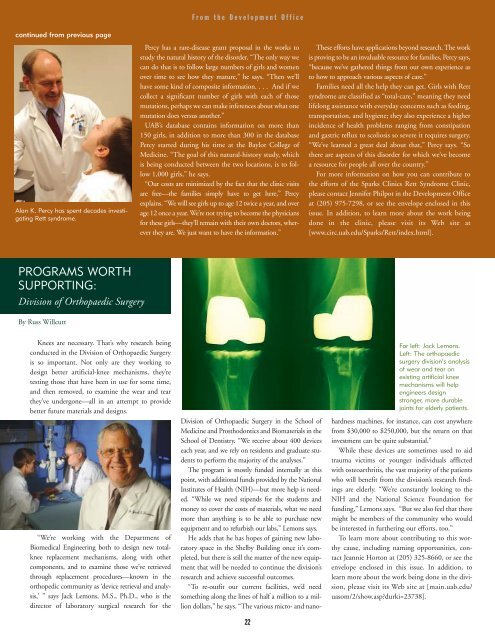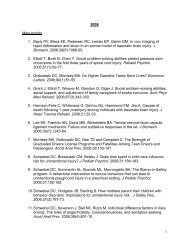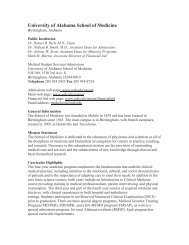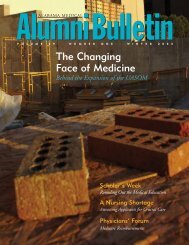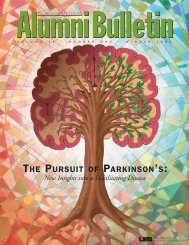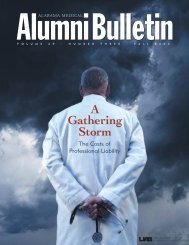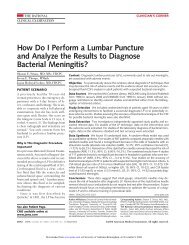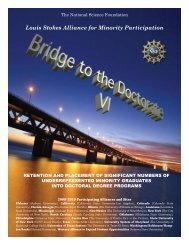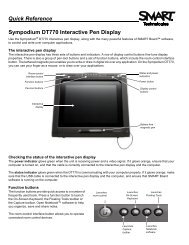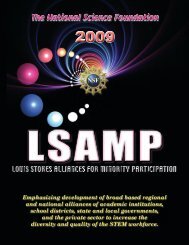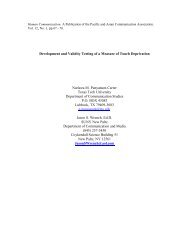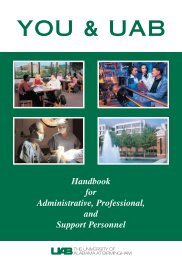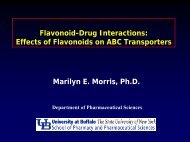uasom doctors uasom doctors - University of Alabama at Birmingham
uasom doctors uasom doctors - University of Alabama at Birmingham
uasom doctors uasom doctors - University of Alabama at Birmingham
Create successful ePaper yourself
Turn your PDF publications into a flip-book with our unique Google optimized e-Paper software.
continued from previous page<br />
Alan K. Percy has spent decades investig<strong>at</strong>ing<br />
Rett syndrome.<br />
From the Development Office<br />
Percy has a rare-disease grant proposal in the works to<br />
study the n<strong>at</strong>ural history <strong>of</strong> the disorder. “The only way we<br />
can do th<strong>at</strong> is to follow large numbers <strong>of</strong> girls and women<br />
over time to see how they m<strong>at</strong>ure,” he says. “Then we’ll<br />
have some kind <strong>of</strong> composite inform<strong>at</strong>ion. . . . And if we<br />
collect a significant number <strong>of</strong> girls with each <strong>of</strong> those<br />
mut<strong>at</strong>ions, perhaps we can make inferences about wh<strong>at</strong> one<br />
mut<strong>at</strong>ion does versus another.”<br />
UAB’s d<strong>at</strong>abase contains inform<strong>at</strong>ion on more than<br />
150 girls, in addition to more than 300 in the d<strong>at</strong>abase<br />
Percy started during his time <strong>at</strong> the Baylor College <strong>of</strong><br />
Medicine. “The goal <strong>of</strong> this n<strong>at</strong>ural-history study, which<br />
is being conducted between the two loc<strong>at</strong>ions, is to follow<br />
1,000 girls,” he says.<br />
“Our costs are minimized by the fact th<strong>at</strong> the clinic visits<br />
are free—the families simply have to get here,” Percy<br />
explains. “We will see girls up to age 12 twice a year, and over<br />
age 12 once a year. We’re not trying to become the physicians<br />
for these girls—they’ll remain with their own <strong>doctors</strong>, wherever<br />
they are. We just want to have the inform<strong>at</strong>ion.”<br />
These efforts have applic<strong>at</strong>ions beyond research. The work<br />
is proving to be an invaluable resource for families, Percy says,<br />
“because we’ve g<strong>at</strong>hered things from our own experience as<br />
to how to approach various aspects <strong>of</strong> care.”<br />
Families need all the help they can get. Girls with Rett<br />
syndrome are classified as “total-care,” meaning they need<br />
lifelong assistance with everyday concerns such as feeding,<br />
transport<strong>at</strong>ion, and hygiene; they also experience a higher<br />
incidence <strong>of</strong> health problems ranging from constip<strong>at</strong>ion<br />
and gastric reflux to scoliosis so severe it requires surgery.<br />
“We’ve learned a gre<strong>at</strong> deal about th<strong>at</strong>,” Percy says. “So<br />
there are aspects <strong>of</strong> this disorder for which we’ve become<br />
a resource for people all over the country.”<br />
For more inform<strong>at</strong>ion on how you can contribute to<br />
the efforts <strong>of</strong> the Sparks Clinics Rett Syndrome Clinic,<br />
please contact Jennifer Philpot in the Development Office<br />
<strong>at</strong> (205) 975-7298, or see the envelope enclosed in this<br />
issue. In addition, to learn more about the work being<br />
done in the clinic, please visit its Web site <strong>at</strong><br />
[www.circ.uab.edu/Sparks/Rett/index.html].<br />
PROGRAMS WORTH<br />
SUPPORTING:<br />
Division <strong>of</strong> Orthopaedic Surgery<br />
By Russ Willcutt<br />
Knees are necessary. Th<strong>at</strong>’s why research being<br />
conducted in the Division <strong>of</strong> Orthopaedic Surgery<br />
is so important. Not only are they working to<br />
design better artificial-knee mechanisms, they’re<br />
testing those th<strong>at</strong> have been in use for some time,<br />
and then removed, to examine the wear and tear<br />
they’ve undergone—all in an <strong>at</strong>tempt to provide<br />
better future m<strong>at</strong>erials and designs.<br />
“We’re working with the Department <strong>of</strong><br />
Biomedical Engineering both to design new totalknee<br />
replacement mechanisms, along with other<br />
components, and to examine those we’ve retrieved<br />
through replacement procedures—known in the<br />
orthopedic community as ‘device retrieval and analysis,’<br />
” says Jack Lemons, M.S., Ph.D., who is the<br />
director <strong>of</strong> labor<strong>at</strong>ory surgical research for the<br />
22<br />
Far left: Jack Lemons.<br />
Left: The orthopaedic<br />
surgery division’s analysis<br />
<strong>of</strong> wear and tear on<br />
existing artificial knee<br />
mechanisms will help<br />
engineers design<br />
stronger, more durable<br />
joints for elderly p<strong>at</strong>ients.<br />
Division <strong>of</strong> Orthopaedic Surgery in the School <strong>of</strong><br />
Medicine and Prosthodontics and Biom<strong>at</strong>erials in the<br />
School <strong>of</strong> Dentistry. “We receive about 400 devices<br />
each year, and we rely on residents and gradu<strong>at</strong>e students<br />
to perform the majority <strong>of</strong> the analyses.”<br />
The program is mostly funded internally <strong>at</strong> this<br />
point, with additional funds provided by the N<strong>at</strong>ional<br />
Institutes <strong>of</strong> Health (NIH)—but more help is needed.<br />
“While we need stipends for the students and<br />
money to cover the costs <strong>of</strong> m<strong>at</strong>erials, wh<strong>at</strong> we need<br />
more than anything is to be able to purchase new<br />
equipment and to refurbish our labs,” Lemons says.<br />
He adds th<strong>at</strong> he has hopes <strong>of</strong> gaining new labor<strong>at</strong>ory<br />
space in the Shelby Building once it’s completed,<br />
but there is still the m<strong>at</strong>ter <strong>of</strong> the new equipment<br />
th<strong>at</strong> will be needed to continue the division’s<br />
research and achieve successful outcomes.<br />
“To re-outfit our current facilities, we’d need<br />
something along the lines <strong>of</strong> half a million to a million<br />
dollars,” he says. “The various micro- and nanohardness<br />
machines, for instance, can cost anywhere<br />
from $30,000 to $250,000, but the return on th<strong>at</strong><br />
investment can be quite substantial.”<br />
While these devices are sometimes used to aid<br />
trauma victims or younger individuals afflicted<br />
with osteoarthritis, the vast majority <strong>of</strong> the p<strong>at</strong>ients<br />
who will benefit from the division’s research findings<br />
are elderly. “We’re constantly looking to the<br />
NIH and the N<strong>at</strong>ional Science Found<strong>at</strong>ion for<br />
funding,” Lemons says. “But we also feel th<strong>at</strong> there<br />
might be members <strong>of</strong> the community who would<br />
be interested in furthering our efforts, too.”<br />
To learn more about contributing to this worthy<br />
cause, including naming opportunities, contact<br />
Jeannie Horton <strong>at</strong> (205) 325-8660, or see the<br />
envelope enclosed in this issue. In addition, to<br />
learn more about the work being done in the division,<br />
please visit its Web site <strong>at</strong> [main.uab.edu/<br />
<strong>uasom</strong>/2/show.asp?durki=23738].


